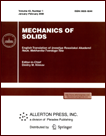 | | Mechanics of Solids
A Journal of Russian Academy of Sciences | | Founded
in January 1966
Issued 6 times a year
Print ISSN 0025-6544
Online ISSN 1934-7936 |
Archive of Issues
| Total articles in the database: | | 13362 |
| In Russian (Èçâ. ÐÀÍ. ÌÒÒ): | | 8178
|
| In English (Mech. Solids): | | 5184 |
|
| << Previous article | Volume 60, Issue 3 / 2025 | Next article >> |
| Akash Kumar Gartia and S. Chakraverty, "Optimizing Shape Functions in the Rayleigh-Ritz Method for Efficient Free Vibration Analysis of Functionally Graded Nanobeams," Mech. Solids. 60 (3), 1799-1821 (2025) |
| Year |
2025 |
Volume |
60 |
Number |
3 |
Pages |
1799-1821 |
| DOI |
10.1134/S0025654425600527 |
| Title |
Optimizing Shape Functions in the Rayleigh-Ritz Method for Efficient Free Vibration Analysis of Functionally Graded Nanobeams |
| Author(s) |
Akash Kumar Gartia (Department of Mathematics, National Institute of Technology Rourkela, Odisha, 769008 India, akgar9@gmail.com)
S. Chakraverty (Department of Mathematics, National Institute of Technology Rourkela, Odisha, 769008 India, sne_chak@yahoo.com) |
| Abstract |
This study explores the effectiveness of different shape functions in solving the free vibration
problem of functionally graded (FG) nanobeams using the Rayleigh-Ritz method. The structural
properties of the nanobeam vary continuously through its thickness, following a power law distribution
of material volume fractions. The FG nanobeam is modeled using the Euler-Bernoulli beam theory,
while small-scale effects are incorporated through Eringen’s nonlocal elasticity theory. Various shape
functions are examined within the Rayleigh-Ritz framework to assess their computational efficiency.
The primary objective is to identify the optimal shape function for this method. To achieve this, the
mass and stiffness matrices are computed, and a generalized eigenvalue problem is formulated to
determine the non-dimensional frequency parameter. The study evaluates the convergence behavior
and computational time of each shape function to identify the most effective option. The results are
validated against existing literature for specific cases, demonstrating the performance of the optimal
shape function under different boundary conditions, small-scale parameters, and power law exponents. Additionally, new insights are provided into the vibrational behavior of FG nanobeams across
various boundary conditions. This focus on shape function optimization enhances computational methodologies in FG nanobeam vibration analysis. |
| Keywords |
free vibration, functionally graded nanobeam, shape functions, Rayleigh-Ritz method |
| Received |
31 January 2025 | Revised |
01 April 2025 | Accepted |
08 April 2025 |
| Link to Fulltext |
|
| << Previous article | Volume 60, Issue 3 / 2025 | Next article >> |
|
 If you find a misprint on a webpage, please help us correct it promptly - just highlight and press Ctrl+Enter If you find a misprint on a webpage, please help us correct it promptly - just highlight and press Ctrl+Enter
|
|

 Russian
Russian  English
English